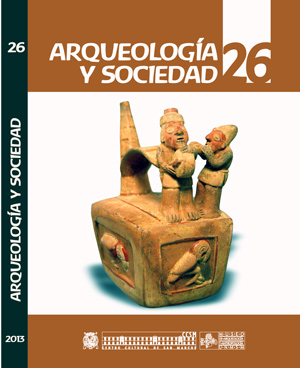REGIONAL HISTORY AND HISTORY OF EARTH NOTES ON CHIRA VALLEY, SAN LUCAS AND AMOTAPE Colan, XVIII-XX CENTURIES
DOI:
https://doi.org/10.15381/arqueolsoc.2013n26.e12409Keywords:
Colan, Amotape, La Chira, Piura, Large Lands, Haciendas, peasant communities, land, wage labor, agrarian modernization.Abstract
In this paper we look forward to present particular characteristics of a peruvian north coast valley in a historical process of capitalist agrarian modernization and the victory of the cotton monoculture between the 16th and 21th century. The valley of La Chira is organized from the viceroyalty times in large properties and rural peasant communities. The spatial area that it includes are the provinces of Paita and Sullana. To the interior of this geographical space it is organized a mercantile parcel agriculture which exploits to the maximum the riverbank and moisturized lands that were disputed between large farms and the indigenous communities like Querecotillo, Colán and Amotape. In the 20th century the great agrarian property assumes the form of companies associating the wage labor and the peasant ‘colonato’ work. In La Chira river’s mouth there survives the agrarian indigenous half-caste economy of communities San Lucas de Colán and Amotape. Comparing macro and micro dimensions we examine the gradual process of agrarian modernization that encourages the regional capitalism in this rural microspace, promoting the emergence of new forms of property, wage labor and parcel work, consolidation of cotton large land farms, and constitution and expansion of new populated centers located between Piura’s countryside and desert.Downloads
Published
Issue
Section
License
Copyright (c) 2013 César Espinoza Claudio

This work is licensed under a Creative Commons Attribution-NonCommercial-ShareAlike 4.0 International License.
THE AUTHORS RETAIN THEIR RIGHTS:
a. The authors retain their trademark and patent rights, and also on any process or procedure described in the article.
b. The authors retain the right to share, copy, distribute, perform and publicly communicate the article published in the Arqueología y Sociedad (for example, place it in an institutional repository or publish it in a book), with an acknowledgment of its initial publication in the Arqueología y Sociedad.
c. The authors retain the right to make a subsequent publication of their work, to use the article or any part of it (for example: a compilation of their works, notes for conferences, thesis, or for a book), provided that they indicate the source. of publication (authors of the work, journal, volume, number and date).






